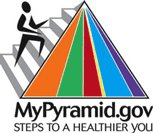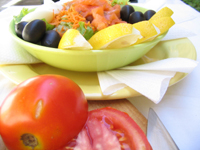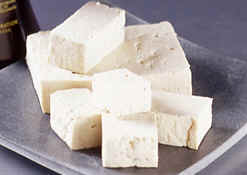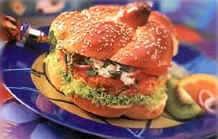Spring 2006: To Your Health
In this Issue:
- Celebrating the 26th Anniversary of National Nutrition Month
- National Nutrition Month® 2006 – Key Messages
- Stress and Its’ Impact on Your Diet and Health
- Cigarette Smoking and Nutrient Intake
- Should You Be Worried About Osteoporosis?
- Feature Food of the Month: Tofu
- Healthy Recipe: Tofu Veggie Burger
Celebrating the 26th Anniversary of National Nutrition Month®
 Step Up to Nutrition and Health!
Step Up to Nutrition and Health!
In 1973, the American Dietetic Association started a National Nutrition Week in response to the nation’s growing nutritionally related health problems. Over the years, the interest and the need for a national focus on nutrition grew and the week evolved into a month long event in 1980. Its’ purpose is to aid in the choices the public makes regarding its’ nutritional intake, as well as helping in developing sound eating and physical activity habits. This month will mark the 26th anniversary of National Nutrition Month®. This year’s theme is Step Up to Nutrition and Health!
As you go about your daily routine, you may often take your body for granted by eating poorly and not devoting time out of your schedule for physical activity. As you look at ways of improving your life, take the necessary steps towards improving your lifestyle choices. Eating well balanced nutritious meals and regularly exercising are two great ways to help improve your chances of living a longer and healthier life. These steps may seem impossible at first, but you have to remember that you are changing the lifestyle that you probably have had for your entire life. Once you make the commitment to change, it will become easier and easier. Take it one day at a time, and you will start to see yourself becoming a better, healthier you.
One great way to help in the transition towards a healthier you is to consult with a registered dietitian to set up a healthful diet and a proper exercise schedule. The American Dietetic Association has released the following:
“Top 10 Reasons Why Consulting a Registered Dietitian Can Help You”
- You have diabetes, cardiovascular problems or high blood pressure. A registered dietitian serves as an integral part of your health-care team by helping you safely change your eating plan without compromising taste or nutrition.
- You are thinking of having or have had gastric bypass surgery. A registered dietitian will help you learn to eat again. Since your stomach can only manage small servings, it’s a challenge to get the right amount of nutrients in your body. A registered dietitian will work with your physician to develop an eating plan for your new needs.
- You have digestive problems. A registered dietitian will work with your physician to help fine-tune your diet so you are not aggravating your condition with fried foods, too much caffeine or carbonation.
- You’re pregnant or trying to get pregnant. A registered dietitian can help make sure you get nutrients like folate, especially during the first three months of pregnancy, lowering your newborn’s risk of neural tube or spinal cord defects.
- You need guidance and confidence for breastfeeding your baby. A registered dietitian can help make sure you’re getting enough iron, vitamin D, fluoride and B vitamins for you and your little one.
- Your teenager has issues with food and eating healthfully. A registered dietitian can assist with eating disorders like anorexia, bulimia and overweight issues.
- You need to gain or lose weight. A registered dietitian can suggest additional sources of healthy weight gain or a restricted calorie eating plan plus regular physical activity for weight loss while still eating your favorite foods.
- You are caring for an aging parent. A registered dietitian can help with food or drug interaction, proper hydration, special diets for hypertension and changing taste buds as you age.
- You want to eat smarter. A registered dietitian can help you sort through misinformation; learn how to read labels at the supermarket; discover that healthy cooking is inexpensive; learn how to eat out without ruining your eating plan; and how to resist workplace temptations.
- You want to improve your performance in sports. A registered dietitian can help you set goals to achieve results – whether you’re running a marathon, skiing or jogging with your dog.
Take charge of your life now with the right steps needed for a healthier you. Click here to see how BRG Dietetics & Nutrition, P.C. can help you reach your goals. And always remember, there is nothing that is out of your power if you set your mind to it.
 National Nutrition Month® 2006 – Key Messages
National Nutrition Month® 2006 – Key Messages
- The food and physical activity choices made today – and everyday – affect your health and how you feel today and in the future. Eating right and being physically active are keys to a healthy lifestyle.
- Make smart choices from every food group. Give your body the balanced nutrition it needs by eating a variety of nutrient-packed foods every day. Just be sure to stay within your daily calorie needs.
- Get the most nutrition out of your calories. Choose the most nutritionally rich foods you can from each food group each day – those packed with vitamins, minerals, fiber and other nutrients but lower in calories.
- Find your balance between food and physical activity. Regular physical activity is important for your overall health and fitness, plus it helps control body weight, promotes a feeling of well-being and reduces the risk of chronic diseases.
- Play it safe with foods. Prepare, handle and store food properly to keep you and your family safe.
Stress and Its Impact on Your Diet and Health
 Chronic stress can impact overall health and well-being. Forty-three percent of all adults suffer adverse health effects due to stress. Stress may be responsible for up to half of the 550 million workdays lost annually because of absenteeism. Eighty-six percent of women feel finding ways to relax and reduce stress is very important but only 32% feel they do a good job of relaxing. Eighty percent of women feel there is just too much to get done everyday and consequently 79% feel drained of energy at the end of the day.
Chronic stress can impact overall health and well-being. Forty-three percent of all adults suffer adverse health effects due to stress. Stress may be responsible for up to half of the 550 million workdays lost annually because of absenteeism. Eighty-six percent of women feel finding ways to relax and reduce stress is very important but only 32% feel they do a good job of relaxing. Eighty percent of women feel there is just too much to get done everyday and consequently 79% feel drained of energy at the end of the day.
For both men and women, feeling stressed can impact diet, sleep and activity patterns. This in turn affects overall health and well-being. The body responds to stress in a variety of ways, including headaches, emotional irritability, insomnia, high blood pressure, depressed immune function and muscular tension. All of these things can deplete your energy and prevent you from getting what you need to get done. It is essential for you to find balance in your life.
Physical stress from illness or injury results in increased nutrient needs. Authorities are still debating whether emotional stress increases your body’s needs for nutrients. It is likely that your body uses Vitamin A, the B Complex Vitamins, Pantothenic Acid, Vitamin E and Linoleic Acid during the stress response. Stress definitely depletes your body of protein. During stress, your body converts protein to fuel at a quick rate. It is therefore essential to ensure adequate protein intake during stressful times.
Stress indirectly negatively effects your nutrition when it causes you to indulge in destructive or unhealthy behavior patterns such as smoking, drinking, substance abuse or eating disorders.
Try the following tips to help find balance in your life thereby cutting down on stress and improving your nutritional health:
- PRIORITIZE: Decide which parts of your life are most important and which parts require less of your attention. Learn to say no. If necessary, let go or cut back on some of your commitments.
- SIMPLIFY: Don’t be afraid to ask for help if you are overloaded with tasks. And accept the help when offered. Learn to delegate chores and then step back. Plan simple meals and involve the whole family in preparation.
- BE ACTIVE: Regular movement is essential for physical and emotional health. It can relieve stress, improve sleep patterns and enhance overall health. Aim for at least 30 minutes of physical activity each day. Exercise causes your body to release certain hormones that we call “feel good” hormones. These hormones are thought to reduce anxiety and improve mood. Participating in physical activity during times of stress can help you deal with the physical aspects of a stress reaction and redirects your attention which allows you to regain a positive attitude and a better perspective. Some ideas for increasing your activity include taking a walk, trying a new sport, or dancing.
- EAT A BALANCED DIET: Eating a balanced diet energizes you and boosts your immune system. Follow the Food Guide Pyramid and eat a variety of foods from each food group daily. Include different colors and textures on your plate.
- SHARE YOUR FEELINGS: Talk to your spouse, a good friend or family member about your feelings. Having others understand makes it easier to deal with the stresses. Remember to laugh every day. Laughter has been shown to reduce pain, strengthen the immune system and decrease stress.
- AVOID GUILT: Don’t let guilt affect your perspective. Have a positive attitude and believe that you can overcome the challenges that you face. Set realistic goals that are attainable. Look for simple solutions to your everyday stressors and relax. Focus on the things that make you feel good and on things you can control. Worrying about things you can’t control just adds to your stress.
- GET ENOUGH REST: Try to go to bed each night and awaken each morning at the same time. This will help set regular body rhythms which will foster a healthier sleep cycle and improve your ability to cope with everything in your life. Find a new hobby. Hobbies are a great way to reduce stress and you can get the satisfaction out of doing something you love.
One of the most common daily challenges for most people is finding the time to prepare a healthy dinner. When you don’t have time to cook, consider preparing meals on the weekends in bulk and freeze for use during the week. This is a great way to relieve the stress of having food ready when dinnertime comes. Or, make a double batch one night and freeze the leftovers for use later in the week.
References:
PDR Family Guide to Nutrition & Health. Jan 1, 2003 pNA
Council for Women’s Nutrition Solutions
Cigarette Smoking and Nutrient Intake
 April 5th is designated as Kick Butts Day! The use of tobacco products may be one of the worst habits that many Americans face every day. Research has found that smoking as little as one cigarette a day can have serious health consequences, including an increased risk of heart disease and a higher risk of dying at an earlier age. Many people face some common problems when trying to quit this deadly addiction. One of the common “reasons” smokers give for not quitting is that smoking helps to curb their appetite. They feel when they stop smoking, they will gain weight.
April 5th is designated as Kick Butts Day! The use of tobacco products may be one of the worst habits that many Americans face every day. Research has found that smoking as little as one cigarette a day can have serious health consequences, including an increased risk of heart disease and a higher risk of dying at an earlier age. Many people face some common problems when trying to quit this deadly addiction. One of the common “reasons” smokers give for not quitting is that smoking helps to curb their appetite. They feel when they stop smoking, they will gain weight.
An article published in the Journal of Nutrition shows an association between cigarette smoking and unhealthy patterns of nutrient intake. The smokers in this study had drastically higher intakes of calories, total fat, saturated fat, cholesterol, and alcohol and lower intakes of polyunsaturated fat, fiber, Vitamin C, Vitamin E and Beta-carotene than the nonsmokers. This can exacerbate the already negative effects of the components of smoke on cancer and coronary heart disease risk. So, make the commitment to yourself to improve your health and lower your risk of cancer and cardiovascular heart disease and “Kick Butt” on April 5th.
For Tips on Avoiding Weight Gain When You Quit Smoking, please visit our Special web section.
Reference: Dallongeville, J. et al. Cigarette smoking is associated with unhealthy patterns of nutrient intake: a meta-analysis. The Journal of Nutrition, Sept 1998 v128 n9 p1450(8).
Should You Be Worried About Osteoporosis?
 As the American population is living longer, it is important to think about the emerging health problems facing the growing amount of elderly people. Osteoporosis and bone health is one of the most important issues facing this nation, and according to the National Osteoporosis Foundation, an estimated 44 million Americans, or 55 percent of the people 50 years of age and older suffer from this debilitating disease. Ten million Americans are estimated to already have the disease and almost 34 million more are estimated to have low bone mass, placing them at increased risk for osteoporosis. Although 80% of those who have osteoporosis are women, men suffer from the disease as well. Significant risk has been reported in people of all ethnic backgrounds. While many people who have osteoporosis are older, the disease can have its affects at any age.
As the American population is living longer, it is important to think about the emerging health problems facing the growing amount of elderly people. Osteoporosis and bone health is one of the most important issues facing this nation, and according to the National Osteoporosis Foundation, an estimated 44 million Americans, or 55 percent of the people 50 years of age and older suffer from this debilitating disease. Ten million Americans are estimated to already have the disease and almost 34 million more are estimated to have low bone mass, placing them at increased risk for osteoporosis. Although 80% of those who have osteoporosis are women, men suffer from the disease as well. Significant risk has been reported in people of all ethnic backgrounds. While many people who have osteoporosis are older, the disease can have its affects at any age.
Much of the focus on bone health and osteoporosis has been dealing with adequate intake of calcium and Vitamin D. About 99% of the calcium found in the body is found in the bones. It is a depletion of the body’s stores of calcium that has been found to be greatly contributing to the weakening of bones as adults age, especially if there is a limited intake of it throughout the life. According to a recent article in the American Journal of Clinical Nutrition, calcium has been shown to have beneficial effects on bone mass at all ages, with an increased amount of Vitamin D possibly being required for optimal bone health as age increases. The article also discusses that supplementation of Vitamin D reduces the number of falls, as well as showing benefits in regard to fractures resulting from falls in the elderly.
Vitamin D is called the “sunshine vitamin” because it is formed in the skin by the action of ultraviolet rays from the sun. Vitamin D is also present in fish oil and some types of saltwater fish such as salmon, halibut, herring, and tuna. Other Vitamin D sources are fortified milk and some cereals.
The best food sources of calcium are from the Milk, Yogurt, & Cheese Group of the Food Guide Pyramid. It is very difficult to get enough calcium without drinking milk. One cup (8 ounces) of milk equals one serving and provides approximately 300 milligrams (mg) of calcium. Plain, low-fat yogurt is especially high in calcium with 415 mg per cup. Cheeses contain varying amounts of calcium. The more firm the cheese, the more calcium it contains. For example, Swiss and Parmesan cheese are excellent sources of calcium, whereas softer cheeses (American, Farmers, Mozzarella, and Provolone) have lower amounts of calcium. Cream cheese is not a good source of calcium.
If you do not enjoy dairy foods, other sources of calcium include: canned fish, such as sardines and salmon (with the bones), tofu, and soymilk, if made with calcium. Almonds, dried beans and peas, and dark green leafy vegetables are fair sources of calcium.
In addition to calcium and Vitamin D, other nutrients play an important role in bone health. These nutrients are magnesium, potassium, Vitamin C, and Vitamin K. These can easily be found in many fruits and vegetables.
Finally, weight bearing exercise has been shown to help prevent osteoporosis. Therefore, as you try to incorporate these nutrient rich foods into your diet, remember to also exercise because you will reap the benefits for years to come.
For Tips on Exercising for Osteoporosis Prevention, please visit our special web section.
To see if you are at risk for Osteoporosis, click here.
Reference:
Nieves, J. Osteoporosis: the role of micronutrients. American Journal of Clinical Nutrition, May 2005 v81 i5 p1232S(8).
Feature Food of the Month – Tofu
 A recent popular trend in the U.S. is the incorporation of different cuisines into our own food choices. One food that is growing in its popularity both for its taste and its nutritional benefits has been tofu. Tofu is a high quality protein substitute for those trying to limit their intake of meats, and can be prepared in a variety of tasty and healthy ways. It is also a good source of B vitamins and iron. When the curdling agent used to make tofu is a calcium salt, the tofu is also an excellent source of calcium.
A recent popular trend in the U.S. is the incorporation of different cuisines into our own food choices. One food that is growing in its popularity both for its taste and its nutritional benefits has been tofu. Tofu is a high quality protein substitute for those trying to limit their intake of meats, and can be prepared in a variety of tasty and healthy ways. It is also a good source of B vitamins and iron. When the curdling agent used to make tofu is a calcium salt, the tofu is also an excellent source of calcium.
Tofu, also known as soybean curd, is made by curdling fresh hot soymilk with a coagulant. Traditionally, the curdling agent used to make tofu is nigari, a compound found in natural ocean water, or calcium sulfate, a naturally occurring mineral. Curds can also be produced by acidic foods like lemon juice or vinegar. The curds then are generally pressed into a solid block.
Tofu and other soy products may lower your risk of heart disease when incorporated into a low fat and low cholesterol diet. In fact, a recent study looking at approximately 75,000 postmenopausal Chinese women found that the group with the highest soy protein intake who consumed 13 grams or more of soy per day had a 37% reduced relative risk of fracturing their bones due to falling than the groups with lower soy intake. Studies are underway to see the effects of increased soy on bone fractures in American women.
Try some of these ideas for introducing tofu to your family:
- Add chunks of firm tofu to soups and stews.
- Mix crumbled tofu into meatloaf.
- Mash tofu with cottage cheese and seasonings to make a sandwich spread.
- Marinate tofu in barbeque sauce, char it on the grill and serve on crusty Italian bread.
- Add a package of taco seasoning to pan-fried crumbled tofu and stuff into a taco shell.
- Stir silken tofu into low fat sour cream for a reduced fat baked potato topper.
References:
Consumption of soy may reduce risk of fracture in postmenopausal women. Nutrition Today, Nov-Dec 2005 v40 i6 p245(1).
Soyfoods Association of America
Healthy Recipe: Tofu Veggie Burgers
Ingredients:
1 block firm tofu, reduced fat
1 medium onion, diced
2 stalks celery, diced
1 large carrot, grated
12 mushrooms, chopped very fine
1 tbsp. olive oil
2 cups quick oatmeal
1 cup water
1 cup seasoned breadcrumbs
1 tsp. poultry seasoning
2 tsp. turmeric
Nonstick spray
Instructions:
- Drain and crumble tofu in a large mixing bowl and set aside.
- Heat a large skillet coated with nonstick spray and add olive oil. Sauté the onion, celery, carrots, and mushrooms.
- Add the oats, herbs and spices to the sauté mixture. Continue cooking until the oats are toasted.
- Add the water and stir to combine.
- Remove the skillet from heat and stir in the breadcrumbs. Let the mixture cool, then add it to the crumbled tofu and mix well. With your hands, shape the mixture into patties or balls.
- Brown the patties or balls until dark on both sides. Eat as is or as part of a sandwich. You can use the tofu balls in sauces or stews. Or, you can bake the mixture in a loaf pan for a delicious Tofu “Meat” Loaf.
Yield: 12 Patties or 24 Tofu Balls
Serving Size: 1 Patty or 2 Balls
Exchanges: 1¼ Starch, 1 Lean Meat
Nutrition Facts:?Calories = 145
Total Fat = 4 grams
Saturated Fat = 0.7 grams
Cholesterol = 0 milligrams
Protein = 7.5 grams
Carbohydrate = 20 grams
Sodium = 188 milligrams
Dietary Fiber = 3 grams
For more healthy recipes, click here.


Leave a Reply
Want to join the discussion?Feel free to contribute!